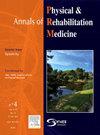3d打印硅胶内侧足弓支架对平足患者足部疼痛的有效性:一项随机对照试验
IF 4.6
3区 医学
Q1 REHABILITATION
Annals of Physical and Rehabilitation Medicine
Pub Date : 2025-08-16
DOI:10.1016/j.rehab.2025.102007
引用次数: 0
摘要
平足是一种引起足部疼痛和功能限制的足部畸形,通常使用定制的足部矫形器作为治疗症状的保守方法。在这项研究中,与传统的全接触式鞋垫(TCI)相比,通过3D打印技术生产的硅胶内侧弓矫形器评估了其减轻疼痛和改善足部功能的能力。目的通过评估主要结果(疼痛和足部功能)和次要结果(足底压力、足跟外翻角和满意度),与TCI进行比较,评估软硬硅胶3d打印矫形器的有效性。方法78例患者随机分为软硬3d打印足弓支架组和TCI组。使用各种工具,包括数字疼痛量表、足功能指数(FFI)问卷、足底压力测量、足跟外翻角测量和满意度调查,在基线、2周、6周和12周对结果进行评估。结果3组患者干预12周后疼痛均明显减轻(P <;0.001),不同矫形器类型间无显著差异。FFI在所有组中均表现出进行性和可比性改善,TCI具有优势。观察到足底压力的重新分布,矫形器之间没有显着差异。所有组的足跟外翻角度与基线相比无明显变化。两组患者满意率均在80%以上,两组间无显著差异。结论3d打印足弓支架与TCI在减轻足部疼痛和改善足部功能方面具有同等效果。它们代表了一种可行的替代方案,但没有表现出优越性。试验注册澳大利亚新西兰临床试验注册中心(ACTRN12624000330549)。本文章由计算机程序翻译,如有差异,请以英文原文为准。
Effectiveness of a 3D-printed silicone medial arch support on foot pain in individuals with pes planus: A randomized controlled trial
Background
Pes planus, a foot deformity that causes foot pain and functional limitations, is often treated with custom-made foot orthoses as a conservative approach to managing symptoms. In this study, silicone medial arch orthotics produced by 3D printing technology were evaluated for their ability to reduce pain and improve foot function, compared to conventional Total Contact Insoles (TCI).
Objectives
To assess the effectiveness of 3D-printed orthoses made from soft and hard silicone by evaluating primary outcomes (pain and foot function) and secondary outcomes (plantar pressure, heel valgus angle, and satisfaction), in comparison to those of TCI.
Methods
A total of 78 participants were randomized into 3 groups: soft and hard 3D-printed arch supports, and TCI. Outcomes were assessed at baseline and 2, 6, and 12 weeks after orthotic wear using various tools, including numeric pain scales, Foot Function Index (FFI) questionnaires, plantar pressure measurements, goniometric measurements of heel valgus angle, and satisfaction surveys.
Results
All 3 groups showed a significant reduction in pain after a 12-week intervention (P < 0.001), with no significant difference between orthotic types. FFI demonstrated progressive and comparable improvement in all groups, with an advantage for TCI. Redistribution of plantar pressure was observed, with no significant difference between the orthoses. The heel valgus angle showed no significant change from baseline in all groups. High satisfaction scores (over 80 %) were achieved for all groups, with no significant differences between them.
Conclusion
The 3D-printed arch supports are as effective as TCI in reducing foot pain and improving foot function in participants with pes planus. They represent a viable alternative, but without demonstrated superiority.
Trial registration
Australian New Zealand Clinical Trials Registry (ACTRN12624000330549).
求助全文
通过发布文献求助,成功后即可免费获取论文全文。
去求助
来源期刊

Annals of Physical and Rehabilitation Medicine
Medicine-Rehabilitation
CiteScore
7.80
自引率
4.30%
发文量
136
审稿时长
34 days
期刊介绍:
Annals of Physical and Rehabilitation Medicine covers all areas of Rehabilitation and Physical Medicine; such as: methods of evaluation of motor, sensory, cognitive and visceral impairments; acute and chronic musculoskeletal disorders and pain; disabilities in adult and children ; processes of rehabilitation in orthopaedic, rhumatological, neurological, cardiovascular, pulmonary and urological diseases.
 求助内容:
求助内容: 应助结果提醒方式:
应助结果提醒方式:


